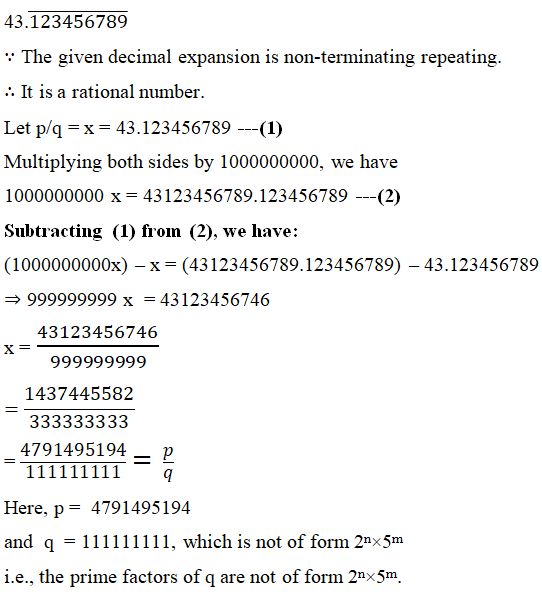NCERT Solutions for Chapter 1 Real Numbers Class 10 Maths
Book Solutions1
(i) 135 and 225
(ii) 196 and 38220
(iii) 867 and 255
Answer
(i) HCF of 135 and 225:
Applying the Euclid’s lemma to 225 and 135, (where 225 > 135), we get
225 = (135 × 1) + 90
Since, 90 ≠ 0, therefore, applying the Euclid’s lemma to 135 and 90, we have:
135 = (90 × 1) + 45
But 45 ≠ 0
∴ Applying Euclid’s Lemma to 90 and 45, we get
90 = (45 × 2) + 0
Here, r = 0, so our process stops. Since, the divisor at the last step is 45,
∴ HCF of 225 and 135 is 45.
(ii) HCF of 196 and 38220:
We start dividing the larger number 38220 by 196, we get
38220 = (196 × 195) + 0
∵ r = 0
∴ HCF of 38220 and 196 is 196.
(iii) HCF of 867 and 255:
Here, 867 > 255
∴ Applying Euclid’s Lemma to 867 and 255, we get
867 = (255 × 3) + 102
Since, 102 ≠ 0, therefore, applying the Euclid’s lemma to 255 and 102, we have:
255 = (102 × 2) + 51
But 51 ≠ 0
∴ Applying Euclid’s Lemma to 102 and 51, we get
102 = (51 × 2) + 0
Here, r = 0, so our process stops. Since, the divisor at the last step is 51,
∴ HCF of 867 and 255 is 51.
2
Answer
Let us consider a positive odd integer as ‘a’.On dividing ‘a’ by 6, let q be the quotient and ‘r’ be the remainder.
∴ Using Euclid’s lemma, we have:
a = 6q + r where, 0≤ r < 6 i.e., r = 0, 1, 2, 3, 4, or 5
i.e., a = 6q + 0 = 6q
or, a = 6q + 1
or, a = 6q + 2
or, a = 6q + 3
or, a = 6q + 4
or, a = 6q + 5
But, a = 6q, a = 6q + 2, a = 6q + 4 are even values of ‘a’.
∴ ‘a’ being an odd integer, we have:
a = 6q + 1,
or, a = 6q + 3,
or, a = 6q + 5
3
Answer
Total number of members = 616
∵ The total number of members are to march behind an army band of 32 members.
HCF of 616 and 32 is equal to the maximum number of columns such that the two groups can march in the same number of columns.
∴ Applying Euclid’s lemma to 616 and 32, we get
616 = (32 × 19) + 8
∵ 8 ≠ 0
∴ Again, applying Euclid’s lemma to 32 and 8, we get
32 = (8 × 4) + 0
∵ r = 0
∴ HCF of 616 and 32 is 8
Hence, the required number of maximum columns = 8.
4
Hint: Let x be any positive integer then it is of the form 3q, 3q + 1 or 3q + 2. Now square each of these and show that they can be rewritten in the form 3m or 3m + 1.
Answer
Let us consider an arbitrary positive integer as ‘x’ such that it is of the form 3q, (3q + 1) or (3q + 2).
For x = 3q, we have
x2 = (3q)2
⇒ x2 = 9q2
= 3(3q2)
= 3m --- (1) [putting 3q2 = m where m is an integer]
For x = 3q+1
x2 = (3q + 1)2
= 9q2 + 6q + 1
= 3(3q2 + 2q) + 1
= 3m + 1 --- (2) [putting 3q2 + 2q = m, where m is an integer]
For x = 3q + 2
x2 = (3q + 2)2
= (9q2 + 12q + 4)
= (9q2 + 12q + 3) + 1
= 3(3q2 + 4q + 1) + 1
= 3m + 1 --- (3) [putting 3q2 + 4q + 1 = m, where m is an integer]
From (1), (2) and (3)
x2 = 3m or 3m + 1
Thus, the square of any positive integer is either of the form 3m or 3m + 1 for some
integer m.
5
Answer
Let us consider a positive integer 'x' such that it is in the form of 3q, (3q + 1) or (3q + 2) and 'b' = 3
Now x = bq + r where, q ≥ 0 and 0 ≤ r < 3
∴ x is of the form 3q, (3q + 1) or (3q + 2).
Note:
For any positive integer, x and b = 3,
x = 3q + r, where q is quotient and r is remainder such that 0 < r < 3.
If r = 0 then x = 3q
If r = 1 then x = 3q + 1
If r = 2 then x = 3q + 2
For x = 3q
x3 = (3q)3
= 27q3
= 9 (3q3)
= 9m --- (1) [putting 3q3 = m, where m is an integer]
For x = 3q + 1
x3 = (3q + 1)3
= 27q3 + 27q2 + 9q + 1
= 9 (3q3 + 3q2 + q) + 1
= 9m + 1 --- (2) [putting (3q3 + 3q2 + 1) = m, where m is an integer]
For x = 3q + 2
x3 = (3q + 2)3
= 27q3 + 54q2 + 36q + 8
= 9 (3q3 + 6q2 + 4q) + 8
= 9m + 8 ...(3) |putting (3q3 + 6q2 + 4q) = m, where m is an integer
From (1), (2), (3) we have:
x3 = 9m, (9m + 1) or (9m + 8)
Thus, x3 of any positive integer can be in the form 9m, (9m + 1) or (9m + 8)
1
(i) 140
(ii) 156
(iii) 3825
(iv) 5005
(v) 7429
Answer
(i) Using factor tree method, we have:
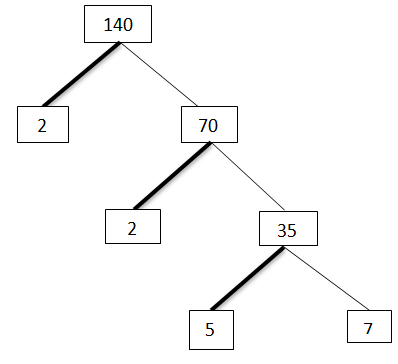
∴ 140 = 2 × 2 × 5 × 7
= 22 × 5 × 7
(ii) Using factor tree method, we have:
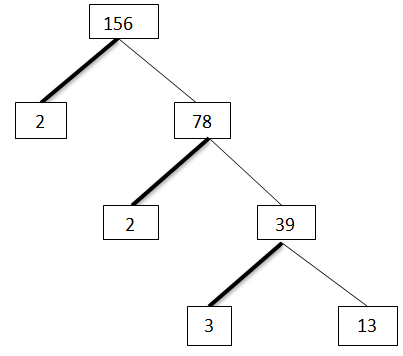
156 = 2× 2 × 3 × 13
= 22× 3 × 13
(iii) Using factor tree method, we have:
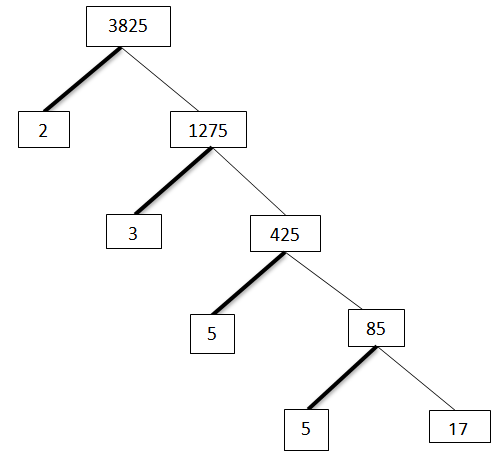
3825 = 3 × 3 × 5 × 5 × 17
= 32 × 5 × 5 × 17
(iv) Using factor tree method, we have:
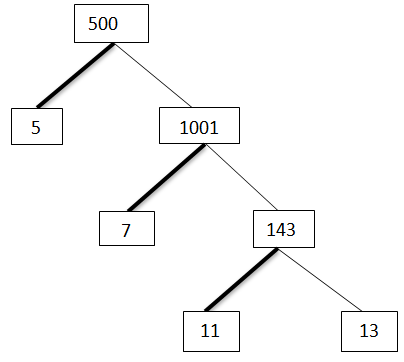
∴ 7429 = 17 × 19 × 23
2
(i) 26 and 91
(ii) 510 and 92
(iii) 336 and 54
Answer
(i) 26 and 91. Using factor-tree method, we have:

⇒ 26 = 2×13
⇒ 91 = 7×13
∴ LCM (26,91) = Product of highest power of all the factors = 2 × 7 × 13 = 182
∴ HCF (26, 91) = Product of least powers of all common factors = 13
Verification:
Now, LCM × HCF = 182 × 13 = 2366
and 26 × 91 = 2366
i.e., LCM × HCF = Product of two numbers.
(ii) 510 and 92. Using the factor tree method, we have:

⇒ 510 = 2×5×3×17
⇒ 92 = 2×2×23
∴ LCM (510, 92) = 2 × 3 × 5 × 17 × 2 × 23 = 23460
∴ HCF of 510 and 92 = 2
Verification:
LCM × HCF = 23460 × 2 = 46920
510 × 92 = 46920
i.e., LCM × HCF = Product of two numbers.
(iii) Using the factor tree method, we have:
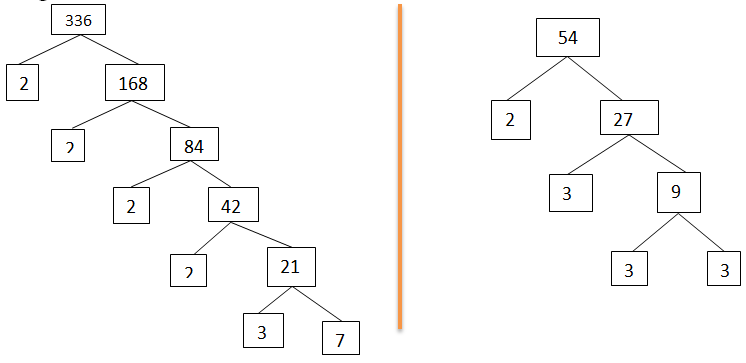
⇒ 54 = 2×3×3×3×3
⇒ LCM of 336 and 54 = 2 × 2 × 2 × 2 × 3 × 3 × 3 × 7 = 3024
∴ HCF of 336 and 54 = 2 × 3 = 6
Verification:
LCM × HCF = 3024 × 6 = 18144
Also 336 × 54 = 18144
Thus, LCM × HCF = Product of the numbers
3
(i) 12, 15 and 21
(ii) 17, 23 and 29
(iii) 8, 9 and 25
Answer
(i) We have
⇒ 12 = 2×2×3
⇒ 15 = 3×5
⇒ 21 = 3×7
∴ HCF of 12, 15 and 21 is 3
LCM of 12, 15 and 21 is 2 × 2 × 3 × 5 × 7 or 420
(ii) We have:
17 = 1 × 17
23 = 1 × 23
29 = 1 × 29
∴ HCF (17, 23, 29) is 1
LCM (17, 23, 29) = 17 × 23 × 29 = 11339
(iii) We have:

∴ HCF (8, 9, 25) is 1
LCM (8, 9, 25) is 2 × 2 × 2 × 3 × 3 × 5 × 5 or 1800
Given that HCF (306, 657) = 9, find LCM (306, 657).
Here, HCF of 306 and 657 = 9
We have:
LCM × HCF = Product of the numbers
∴ LCM × 9 = 306 × 657
⇒ LCM = 34 × 657/9
= 22338
Thus, LCM of 306 and 657 is 22338.
4
Answer
Here, HCF of 306 and 657 = 9We have:
LCM × HCF = Product of the numbers
∴ LCM × 9 = 306 × 657
⇒ LCM = 34 × 657/9
= 22338
Thus, LCM of 306 and 657 is 22338.
5
Answer
Here, n is a natural number and let 6n end in 0.∴ 6n is divisible by 5.
But the prime factors of 6 are 2 and 3.
⇒ 6n = (2 × 3)n
i.e., In the prime factorisation of 6n, there is no factor 5.
Since, by the Fundamental Theorem of Arithmetic, every composite number can be expressed as a product of primes and this factorisation is unique apart from the order in which the prime factorisation occurs.
∴ Our assumption that 6n ends in 0, is wrong.
6
Answer
We have 7 × 11 × 13 + 13= 13 [(7 × 11) + 1]
= 13 [78]
i.e., 13 × 78 cannot be a prime number because it has a factor 13.
∴ 13 × 78 is a composite number.
Also 7 × 6 × 5 × 4 × 3 × 2 × 1 + 5
= 5 [7 × 6 × 4 × 3 × 2 × 1 + 1]
which is also not a prime number. [∵ it has a factor 5]
Thus, ‘7 × 11 × 13 + 13’ and ‘7 × 6 × 5 × 4 × 3 × 2 × 1 + 5’ are composite numbers.
7
Answer
Time taken by Sonia to drive one round of the field = 18 minutes.
Time taken by Ravi to arrive one round of the field = 12 minutes.
The L.C.M. of 18 and 12 gives the exact number of minutes after which they meet at the starting point again.
We have:
⇒ 18 = 2 × 3 × 3
and 12 = 2 × 2 × 3
∴ LCM of 18 and 12 = 2 × 2 × 3 × 3 = 36
Thus, they will meet again at the starting point after 36 minutes.
1
Answer
Let √5 be a rational number.
∴ We have to find two integers a and b (where, b ≠ 0 and a and b are coprime)
such that a/b = √5
⇒ a = √5.b ---(1)
Squaring both sides, we have
a2 = 5b2
∴ 5 divides a2
⇒ 5 divides a ---(2)
[∵ a prime number ‘p’ divides a2 then ‘p’ divides ‘a’, where ‘a’ is positive integer.]
∴ a = 5c, where c is an integer.
∴ Putting a = 5c in (1), we have
5c = √5. b
or (5c)2 = 5b2
⇒ 25c2 = 5b2
⇒ 5c2 = b2
⇒ 5 divides b2
⇒ 5 divides b ---(3)
From (2) and (3),
a and b have at least 5 as a common factor.
i.e., a and b are not coprime.
∴ Our supposition that √5 is rational is wrong.
Hence, √5 is irrational
2
Answer
Let 3+2√5 is rational.
∴ We can find two coprime integers ‘a’ and ‘b’
such that [3+2√5] = a/b, where b ≠ 0

⇒ (1) is a rational
⇒ √5 is a rational
But this contradicts the fact that √5 is irrational.
∴ Our supposition is wrong.
3+2√5 is an irrational.
3(i)
(i) 1/√2
Answer
(i) We have,
Since, the division of two integers is rational.
∴ 2a/b is a rational.
From (1), √2 is a rational number which contradicts the fact that √2 is irrational.
∴ Our assumption is wrong.
Thus, 1√2 is irrational.
3(ii)
(ii) 7√5
Answer
(ii) Let us suppose that 7√5 is rational.
Let there be two coprime integers ‘a’ and ‘b’.
Such that 7√5 = a/b , where b ≠ 0
Now, = 7√5 = a/b

This contradicts the fact that √5 is irrational.
∴ We conclude that 7√5 is irrational.
3(iii)
(iii) 6+√2
Answer
(iii) Let us suppose that 6+√2 is rational.
∴ We can find two coprime integers ‘a’ and ‘b’ (b ≠ 0),
such that, 6+√2 = a/b
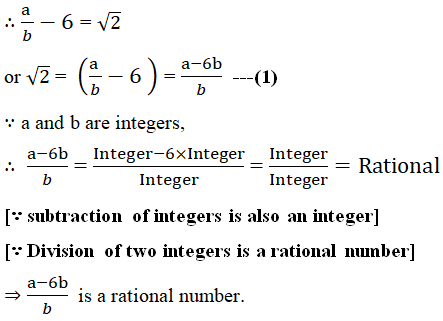
From (1), √2 is a rational number, which contradicts the fact that √2 is an irrational number.
∴ Our supposition is wrong.
⇒ 6+ √2 is an irrational number.
1
(i) 13/ 3125
(ii) 17/18
(iii) 64/455
(iv) 15/1600
(v) 29/343
(vi) 23/23 53
(vii) 129/225775
(viii) 16/15
(ix) 35/50
(x) 77/ 210
Answer
(i) 13/3125
∵ 3125 = 5 × 5 × 5 × 5 × 5 = 55
= 20 × 55, [∵ 20 = 1]
which is of the form (2n · 5m)
∴ 13/3125 is a terminating decimal.
i.e., 13/3125 will have a terminating decimal expansion.
(ii) 17/8
∵ 8 = 2 × 2 × 2 = 23 = 1 × 23
= 50 × 23, which is of the form 5m · 2n
∴ 17/8 will have a terminating decimal expansion.
(iii) 64/455
∵ 455 = 5 × 7 × 13, which is not of the form 2n · 5m
∴ 64/455 will have a non-terminating repeating decimal expansion.
(iv) 15/1600
∵ 1600 = 2 × 2 × 2 × 2 × 2 × 2 × 5 × 5
= 26 × 52, which is of the form 2n · 5m
∴ 15/1600 will have a terminating decimal expansion.
(v) 29/343
∵ 343 = 7 × 7 × 7 = 73, which is not of the form 2n·5m.
∴ 29/343 will have a non-terminating repeating decimal expansion.
(vi) 23/2352
Let p/q = 23/2352
i.e., q = 23 · 52, which is of the form 2n · 5m.
∴ 23/2352 will have a terminating decimal expansion.
(vii) 129/225775
Let p/q = 129/225775
i.e., q = 22.57.75, which is not of the form 2n.5m.
∴ 129/225775 will have a non-terminating repeating decimal expansion.
(viii) 6/15
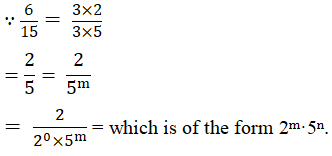
∴ 6/15 will have a terminating decimal expansion.
(ix) 35/50
∵ 50 = 2 × 5 × 5 = 21 × 52, which is of the form 2n·5m.
∴ 35/50 will have a terminating decimal expansion.
(x) 77/210
∵ 210 = 2 × 3 × 5 × 7 = 21 · 31 · 51 · 71,
which is not of the form of 2n · 5m.
∴ 77/ 210 will have a non-terminating repeating decimal expansion.
2
Write down the decimal expansions of those rational numbers in Question 1 above which have terminating decimal expansions.
(i) 13/ 3125
(ii) 17/18
(iii) 64/455
(iv) 15/1600
(v) 29/343
(vi) 23/23 53
(vii) 129/225775
(viii) 16/15
(ix) 35/50
(x) 77/ 210
Answer
(i) 13/3125
We have,
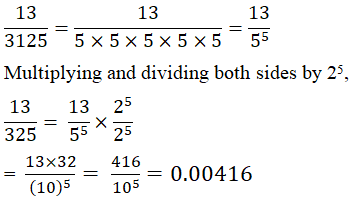
(ii) 17/18
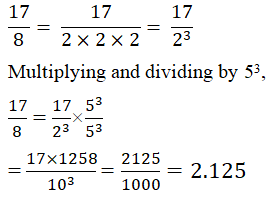
(iii) 64/455 represents non-terminating repeating decimal expansion.
(iv) 15/1600
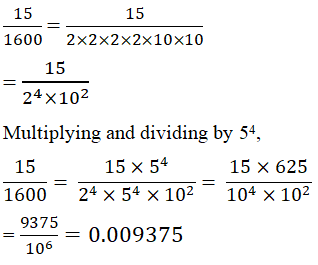
(v) 29/343, represents a non-terminating repeating decimal expansion.
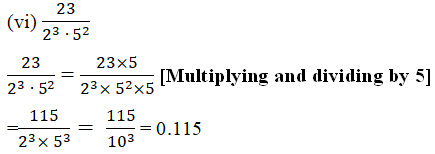
(vii) ![]() represents a non-terminating repeating decimal expansion.
represents a non-terminating repeating decimal expansion.
(viii) 6/15
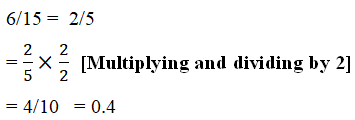
(ix) 35/50
35/50 = 0.7
(x) 77/ 210 , represents a non-terminating repeating decimal expansion.
3
The following real numbers have decimal expansions as given below. In each case, decide whether they are rational or not. If they are rational, and of the form , what can you say about the prime factors of q?
(i) 43.123456789
(ii) 0.120120012000120000...
![]()
Answer
(i) 43.123456789
∵ The given decimal expansion terminates.
∴ It is a rational of the form p/q
⇒ p/q = 43.123456789
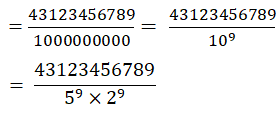
Here, p = 43123456789 and
q = 29 × 59
∴ Prime factors of q are 29 and 59.
(ii) 0.120120012000120000 .....
∵ The given decimal expansion is neither terminating nor non-terminating repeating,
∴ It is not a rational number.
(iii)
